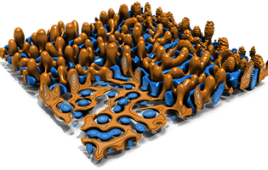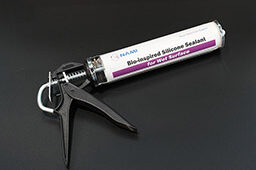
The tiny flexible 3D bioprinter developed at UNSW Sydney was able to 3D print a variety of materials with different shapes on the surface of a pig’s kidney. [Photo courtesy of Dr Thanh Do]
Engineers in Australia say they developed a miniature robotic arm that could 3D print biomaterial directly onto human organs.
UNSW Sydney researchers developed the flexible, soft robotic arm for 3D bioprinting. This process fabricates biomedical parts from so-called “bioink” to construct natural, tissue-like structures. Predominantly used for research purposes, the process normally requires the use of large 3D printing machines to produce cellular structures outside the body.
However, Dr. Thanh Nho Do and his Ph.D. student, Mai Thanh Thai, collaborated with other UNSW researchers to develop a new bioprinting method. Scientia professor Nigel Lovell, Dr. Hoang-Phuong Phan and associate professor Jelena Rnjak-Kovacina collaborated on the research. They published their findings in Advanced Science.
The proof-of-concept device, called F3DB, can go into the body just like an endoscope. It directly delivers multilayered biomaterials onto the surface of internal organs and tissues. F3DB features a highly maneuverable swivel head that prints the bioink. It attaches to the end of a long, flexible, snake-like robotic arm. The researchers say it can all be controlled externally.
Within five to seven years, the engineers feel that — with further development — medical professionals could potentially use their technology to access hard-to-reach areas inside the body through small skin incisions or natural orifices. The engineers already performed early testing inside an artificial colon. They also 3D printed a variety of materials with different shapes on the surface of a pig’s kidney.
Addressing significant limitations
Do explained that the approach addresses existing 3D bioprinters’ limitations such as surface mismatches and structural damage. He said it offers the potential for precise 3D wound reconstruction, including gastric wall injuries or colon damage and disease.
With a flexible body, the prototype can 3D print all kinds of biomaterials through confined and hard-to-reach spaces.
“Existing 3D bioprinting techniques require biomaterials to be made outside the body and implanting that into a person would usually require large open-field open surgery which increases infection risks,” said Dr. Do. “Our flexible 3D bioprinter means biomaterials can be directly delivered into the target tissue or organs with a minimally invasive approach.”
The smallest F3DB prototype they produced comes in at a similar diameter to commercial therapeutic endoscopes. At that size (approximately 11-13mm), the device is small enough for insertion into a human gastrointestinal tract. The researchers say they could scale it even smaller for future uses.
“Currently, there are no commercially available devices that can perform in situ 3D bioprinting on internal tissues/organs distanced from the skin surface,” Lovell said. “Some other proof-of-concept devices have been presented, but they are much more rigid and tricky to use in complex and confined spaces inside the body.”
Device features for the soft robotics platform
The device includes a three-axis printing head directly mounted onto the tip of a soft robotic arm. The head features soft artificial muscles for movement in three directions. According to the engineers, this works very similar to conventional desktop 3D printers.
Due to hydraulics, the soft robotic arm can bend and twist. The engineers can fabricate it at any length required and they can finely tune its stiffness with various elastic tubes and fabrics.
According to the researchers, they can program the nozzle to print pre-determined shapes. However, it can also operate manually for more complex or undetermined bioprinting when required. The team also introduced a machine learing-based controller to aid the printing process.
To demonstrate feasibility, the UNSW team tested the cell viability of living biomaterial after the system printed it. Experiments demonstrated no effect on the cells related to the process. Most cells were alive post-printing and continued to grow for the next seven days. The researchers observed four times as many cells one week after printing.
Developing an all-in-one tool
The researchers say F3DB could potentially represent an all-in-one endoscopic surgical platform for performing a variety of functions. These include surgery for removing certain cancers, such as colorectal cancer. According to the UNSW team, the printing head can operate as a type of “electric scalpel” to mark then cut away cancerous lesions.
Users can also direct water through the nozzle to simultaneously clean any blood and excess tissue from the site. Immediate 3D printing of biomaterial while the robotic arm remains in place can promote faster healing, too. The researchers say they demonstrated these multi-functional attributes on a pig’s intestine.
“Compared to the existing endoscopic surgical tools, the developed F3DB was designed as an all-in-one endoscopic tool that avoids the use of changeable tools which are normally associated with longer procedural time and infection risks,” Mai Thanh Thai said.
For its next steps, the team plans in vivo testing on living animals. They received a provisional patent for the technology and also aim to introduce additional features. These could include an integrated camera and a real-time scanning system. The real-time scanning would reconstruct the 3D tomography of the moving tissue inside the body.




